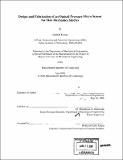Design and fabrication of an optical pressure micro sensor for skin mechanics studies
Author(s)
Kumar, Siddarth
DownloadFull printable version (10.71Mb)
Alternative title
Optical pressure micro sensor for skin mechanics studies
Other Contributors
Massachusetts Institute of Technology. Dept. of Mechanical Engineering.
Advisor
Mandayam A. Srinivasan.
Terms of use
Metadata
Show full item recordAbstract
The mechanics of skin is as central to touch as optics is to vision and acoustics is to hearing. With the advent of novel imaging technologies such as the Optical Coherence Tomography (OCT), we are now able to view structures within the skin to a resolution of a few microns in vivo and non-invasively. To fully understand the role of biomechanics of the skin in interpreting touch, we need to develop a quantitative understanding of how spatio temporal loads imposed on the surface of the skin are transmitted to mechanoreceptor locations within the skin. The following thesis presents a description of the design and fabrication of an Optical Pressure Sensor Device to be used in conjunction with an Optical Coherence Tomography Apparatus to quantify loads incident on the fingerpad surface. The Optical Pressure Sensor is a five layer PDMS based device having a total thickness of 150 microns. It consists of two layers of a textured pattern separated by a layer of "Soft" PDMS of thickness 100 microns. The top and bottom protective layers are of PDMS and have a thickness of 20 microns each. "Soft" PDMS is a combination of PDMS and the silicone oil "Fluid 200" and has a Young's Modulus less than that of Human Skin. (cont.) The entire device is fabricated bottom up on a silicon wafer using soft lithography techniques and the textured pattern is imprinted onto the PDMS using photolithography techniques. This flexible pressure sensor is designed to be used on the fingerpad skin to determine the pressure distribution due to incident loads. The sensor is placed between the OCT head and the finger pad to be imaged. The OCT head (along with the indenter) acts as the mechanical stimulus and is used to indent the finger pad. As a result of this stimulus, the human skin along with the pressure sensor gets deformed and both these deformations are picked up by the OCT image. The deflection between the two bands of patterns is used to estimate the stress at the pressure sensor and skin interface through the development of a continuum mechanics model which is also developed and introduced in this thesis. The manufactured device is tested and calibrated for use with the fingerpad.
Description
Thesis (S.M.)--Massachusetts Institute of Technology, Dept. of Mechanical Engineering, 2006. Includes bibliographical references (leaves 78-80).
Date issued
2006Department
Massachusetts Institute of Technology. Department of Mechanical EngineeringPublisher
Massachusetts Institute of Technology
Keywords
Mechanical Engineering.